Bird Poaching - Field Report
One hot summer sunday, when me and my birding buddies went out to Siruthavur lake (located at the outskirts of chennai), we were welcomed by the gunshots from the other side of the lake.
Instantly, we could see a flock of birds taking off from that place. They moved to little away from gunshot place and settled down for their feeding.
Our binoculars and lenses came out promptly trying to figure out the source of the shot.
Not able to find anything, we went on our activities of birding and started noting down the birding activities at the lake.
While I moved on near to lake, trying to "shoot" some close flying shots of cotton teals, rest were scanning the grounds and water for birds from the road itself.
We heard few more gunshots and as usual, unable to find out the source (as the poachers were hiding) during this time too.
Below photo story is as developed during this course of time.
Location: Siruthavur lake, Thiruporur, Chennai, India.
Photos by: Gnanskandan (GK), Subramanian Sankar, Samyak Kaninde. Deepak and Gayathri were constantly keeping watch on poachers and forest officials during all this drama.
7:32AM - The poacher (in khaki) came to the light to collect the dead birds. Seen here are two local boys walking along with the poacher.

The poacher (in khaki) and local kids (helping them) colleting the dead birds. The Painted Stork (Mycteria leucocephala) as seen here.

The Little Cormorant (Phalacrocorax niger) or The Glossy Ibis (Plegadis falcinellus) being handed over.
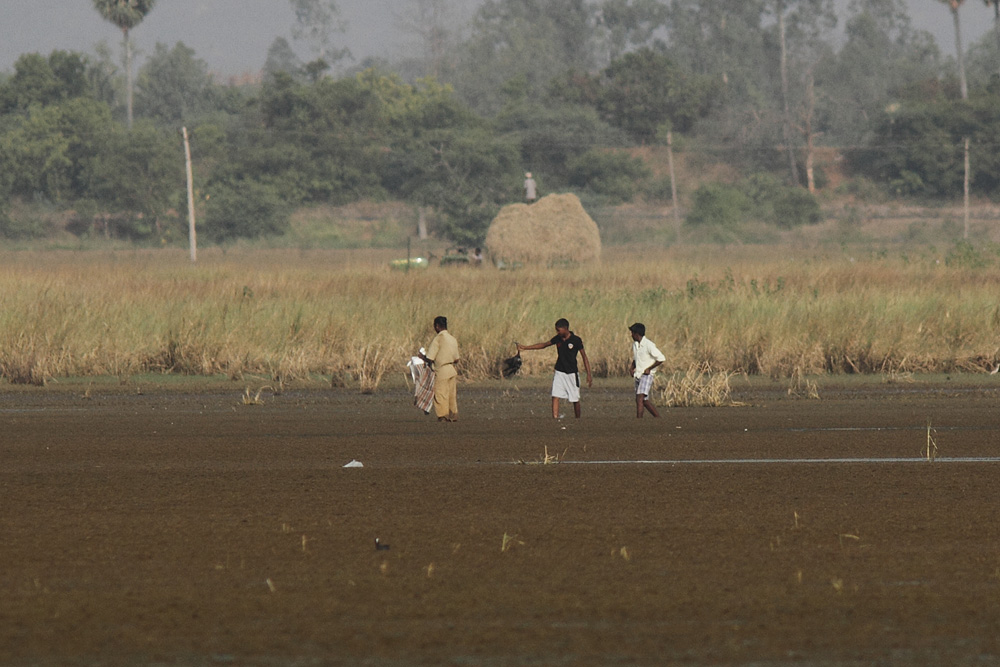
The Purple Heron (Ardea purpurea) pair - one having a fish in the beak and other landing completely ignorant of what is happening in the background.

The two standing birds near the boy collecting dead birds are either 'live birds tied with ropes in muddy soil' or 'dead stuffed birds' kept their as bet to attract other birds flocks. The green patch beside the boy is a hide used by the poacher sitting there with a loaded gun. He was still hiding while the others were kept collecting dead birds.

The first poacher went behind a hide and the the shooter poacher (old guy with turban)came out. The local boy is inspecting the baiting bird. Not sure if it was 'alive and tied' or 'dead stuffed bird'.

7:49AM - After collecting almost all birds, locals and poachers parted their ways. The forest guards had just arrived and we briefed them about this and showed the poachers and asked them to hurry up to go behind them to catch them red handed.
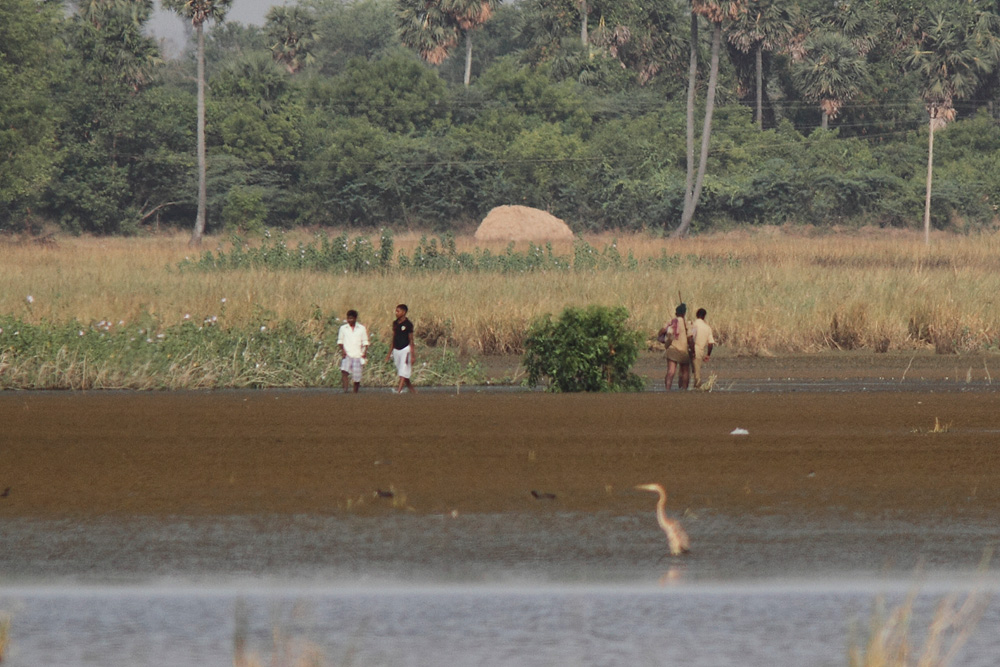
The FD guards were shouting from behind and running a great distance towards poachers. Looking at this, the poacher ran with his bags towards the FD fellows. We could not understand what was happening and what is to happen next.

The poacher had hid the bags with dead birds in the green vegetation(the egret flying over that patch on RHS) and started running back to join his old mate waiting at the other end. The two local boys were as clueless as we were to understand what was happening.
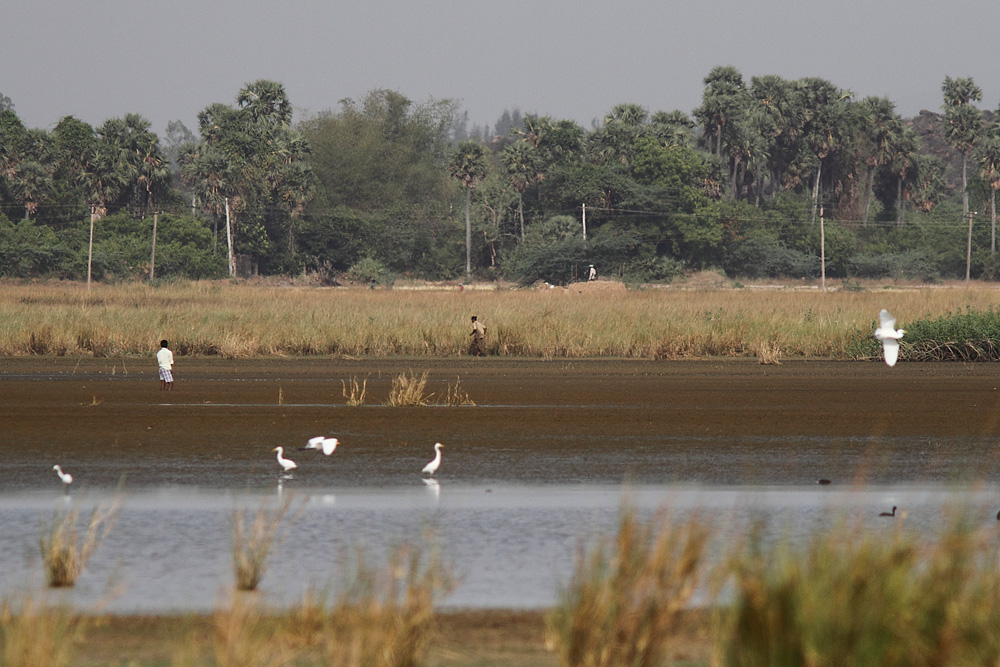
7:54AM - Finally, we could see the Forest department guards reaching the scene. Later they told us that they were shouting and posing as a potential buyers for the birds. The local kid was dragging one of the dead bird to be taken away but later he threw it away. Probably, as we were watching from road, the kid thought of not carrying it in hands.

The FD guards negotiating with one poacher while the other is little away. The other poacher still had the gun and the FD guards could have been in trouble too.

Once both the poachers were at hand, the FD guards had them caught over and a long talks and long wait to see them at the roads started. The local boys escaped from the other side and went back to village.

09:05AM - Meanwhile, one more FD guard came in and joined the two. The old poacher was apparantly doing some drama about not feeling well and this new FD guard was attending him at the other side. The previous FD guards got hold of one poacher and were taking him to their department on the bike. The FD guard showing the dead The Eurasian Spoonbill (Platalea leucorodia).
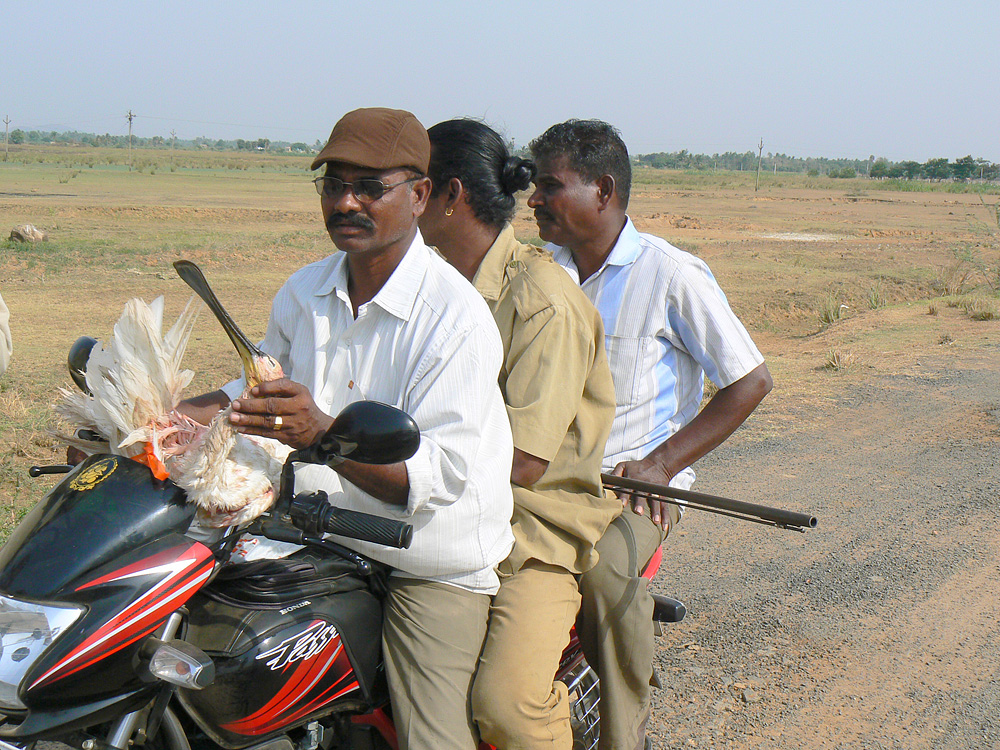
Finally, Mr. Moorthy, a forest ranger from thiruporur division, came promptly in a jeep to take away the old poacher to take into custody. Fortunately, the local boys also turned up on a bike this time to take away the dead bird. We told ranger about it and he took them into custody too.
Below - the dead birds were taken out of the bags and kept on the steps of forest department office.

The dead birds at the FD office.

9:57AM - The Cotton Pygmy Goose (or the Cotton Teal) (Nettapus coromandelianus) - one dead, one alive. The alive one was having a broken legs and was sent to the zoo to be taken care of. It later succumbed to the injury and shock and died later. The cotton like white color of this bird was all soaked in the blood red. Unfortunate to see such a beauty in such a state.
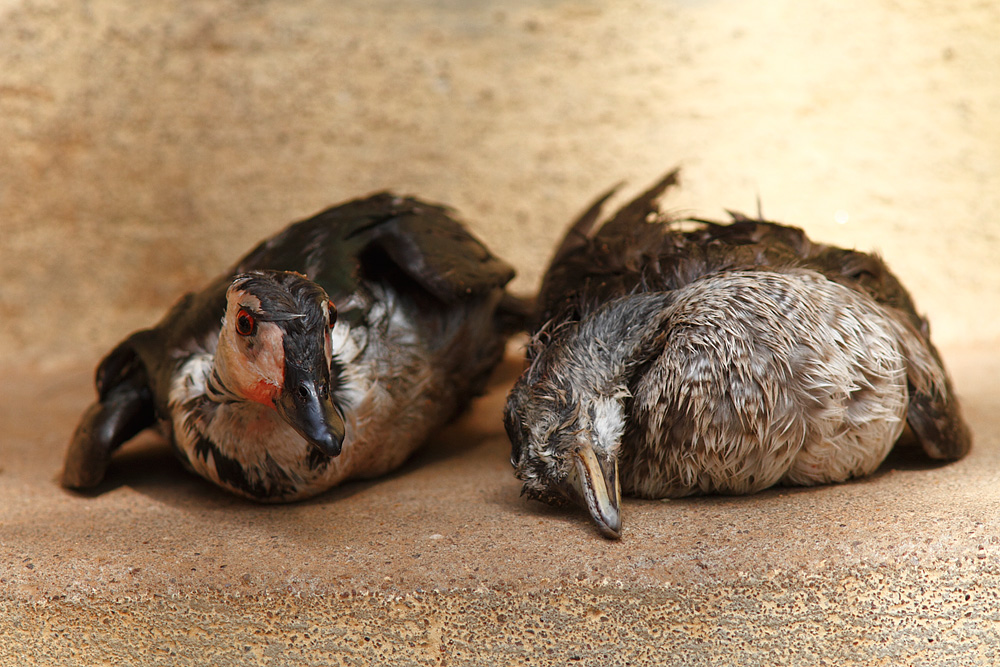
This was the second poaching incident I witnessed within the span of 3 months after the last kelambakkam incident(read below in links). The places are quite nearby to each other and done by the same people (Narikurava tribe mostly).
But, the prompt response by the forest department from Thiruporur division was something pleasantly unexpected. The ranger and DFO were following it with us about all happening in the field during this 2-3 hour drama. With our experience from these incidents, I would like to make following observations :
1. We need a dedicated hotline number for a city/state/country (depending on the feasibility) to report the poaching related incidents. Most of the time, we are spending a lot of time in ringing our friends, getting the correct contacts and talking to the officials. Sometimes, the officials/forest guards does not even turn up at the incident (like my previous kelambakkam poaching incident).
2. The task force which is specialised in handling poachers and work on the ground to nab them red-handed is required. The forest guards did not even carry a stick while they were running behind the poachers who were having guns. Fortunately, nothing happened in this case.
3. The poachers, moreover, require an alternate livelihood. Unless, we find solutions to their bread and butter problems, we can not stop poaching.
4. The poachers were let off by paying a fine of just 10000/- which we think does not do justice to the repeated killings of these birds. The law has to be strengthened for stringent punishments according to the different wildlife classification of poached birds.
5. Helpline Numbers for Chennai's wildlife Crimes Or Wild Animal Rescues : (044)22200335, 94454 68593, 9449 58197, 99944 01291.
If you have different ideas/suggestions/feedback, please put them down in comments below. The debate might not change the situation on field in a day, but could be a beginning for a better world in future.
Related Links:
TOI Article on this incident
Conservation India Article by GK.
TOI Article about Kelambakkam Bird Poaching